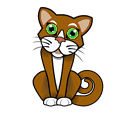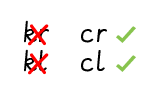 |
 |
| Why is it c in cat... | ... but k in kitten? |
 |
Did you know, we use /k/ to show this sound that starts both cat and kitten but the most common spelling choice for it is c not k?! |
|
If the vowel after the /k/ is a, o or u, we usually use c: 
Examples: call, carrot |
|
If the vowel is e or i, we usually use k. keep, kettle |
|
If a c is followed by e or i then it makes the /s/ sound. certain |
|
If the next letter is a consonant e.g. r or l , we almost always use c. 
crab, cricket, crumb |
The Spellzone interactive course is intended to be used online and may not be printed.
"Thank goodness for Spellzone during this remote learning phase. The site is easy for students to navigate independently and they're really enjoying the activities and spelling games. You get an awful lot for your money with Spellzone. Really reassuring is the very prompt response with helpdesk queries. I've very rarely needed the helpdesk, but when I have, the issue has been addressed and sorted within a very short time."
Sarah Taggart, Oasis Academy Lord's Hill